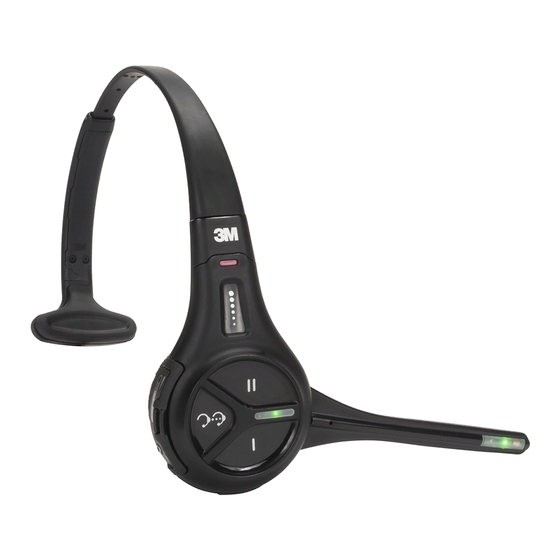
3M Drive-Thru G5 Technical Bulletin
Hide thumbs
Also See for Drive-Thru G5:
- Operating instructions manual (77 pages) ,
- Installation manual (74 pages) ,
- Technical bulletin (12 pages)
Advertisement
Table of Contents
- 1 Optimizing Inbound Audio Level
- 2 Proper Fitting of Headset
- 3 Volume Setting on Headset
- 4 Inbound Volume Setting on Basestation
- 5 Microphone Preamp Gain Setting on Basestation
- 6 Inbound MIC Noise Reduction Level Setting on Basestation
- 7 Location of the Speaker Post Viz-A-Viz the Drive Thru Lane
- 8 Microphone Angles Inside the Speaker Post
- Download this manual
3M™ Drive-Thru Communication System G5
Technical Bulletin - #157
Optimizing Inbound Audio volume level
Overview:
The default (or Factory) settings on the basestati o n have been optimized to provide the best Inbound audio level for a typical drive thru
operation. Every installation and store is unique and as such several factors affect the level of the inbound audio. The purpose of this
technical bulletin is to explain the effects of these factors and understand how to mitigate them.
Factors affecting Inbound audio level:
• Fitting of the headset.
• Volume setting on the headset.
• Settings on the basestation (Microphone Preamp Gai n , Inbound Volume and Inbound Mic Noise Reduction)
• Ambient noise level at the order point.
• Where the speaker post is located in the drive thru lane
Recommended sequence of steps to optimize Inbound Volume (detailed in sub-sections below):
1. Make sure headset is properly fitted so the speaker is seated on the ear. – Check for levels
2. Raise volume on the headset – Check for levels
3. Raise the Inbound volume settings on the basestation – Check for levels
4. Raise Microphone Preamp Gain in steps. – Check for levels and ensure there is no echo while taking into the headset mic.
5. Decrease Inbound Mic Noise Reduction setting – Check Inbound volume level, does the system pickup more background noise?
6. Measure ambient noise at the speaker post - 1 meter away (~ 3 feet) on axis to the mi c rophone.
If the Sound Meter measure more than 65dB, you may have to create a barrier between the speaker post and the noise source.
Advertisement
Table of Contents

Subscribe to Our Youtube Channel
Summary of Contents for 3M Drive-Thru G5
- Page 1 3M™ Drive-Thru Communication System G5 Technical Bulletin - #157 Optimizing Inbound Audio volume level Overview: The default (or Factory) settings on the basestati o n have been optimized to provide the best Inbound audio level for a typical drive thru operation.
- Page 2 Optimizing Inbound audio level: 1. Proper fitting of headset Make the following adjustments to the headset to make sure it is not only comfortabl e , less likely to fall off and easy for you to hear and speak clearly; but to also make sure the speaker on the headset is properly aligned to your ear. a) Adjust the size of the headband until the ear pad rests against one ear and the comfort pad cushi o n rests just above the other ear.
- Page 3 3. Inbound Volume setting on basestation Changing the inbound microphone volume affects the sound vol u me coming from the customer order point microphone. The range is 0 (silent) to 20 (maximum). The default factory setting for the Inbound Volume is at 17. To turn up the inbound microphone volume: •...
- Page 4 5. Inbound Mic Noise Reduction Level setting on basestation The inbound microphone noise reduction level setting helps remove the background (ambient) noise that is picked up by the microphone at the Order Point, when a customer is placing an order. The basestation’s noise reduction level is factory set to Medium.
- Page 5 5. Location of the speaker post viz-a-viz the drive thru lane The ideal distance between the microphone and the customer (in the car) is about 3 feet (on axis to the microphone) . A customer’s ability to park himself or herself right in front of the speaker post’s mi c rophone, at the recommended distance, depends on the following: - Where the Speaker post is located on a drive thru and - A car’s turn radius...
- Page 6 Product Use: Many factors beyond 3M's control and uniquely within user's knowledge and control can affect the use and performance of a 3M product in a particular application. Given the variety of factors that can affect the use and performance of a 3M product, user is solely responsible for evaluating the 3M product and determining whether it is fit for user's particular purpose and suitable for user's method of application.












Need help?
Do you have a question about the Drive-Thru G5 and is the answer not in the manual?
Questions and answers